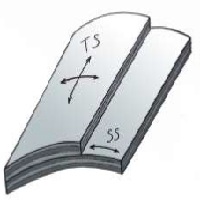A Novel Insight into Keratoconus: Mechanical Fatigue of the Cornea
Medical hypothesis discovery and innovation in ophthalmology,
Vol. 1 No. 1 (2012),
1 March 2012
,
Page 14-17
Abstract
An integrated model for keratectasia risk assessment has received much attention over many years. The objective of this article is to propose a more complete, conceptual model by which high risk individuals can be screened, even with no topographic irregularity or corneal thinning. In this model, corneal ectasia results from the fatigue effect of cyclic shear stress and tensile stress, caused by eye rubbing and fluctuating intraocular pressure (IOP), respectively, on corneal microstructures. The model clarifies the importance of the magnitude of shearing force applied by eye rubbing, the amplitude of IOP fluctuations, the frequency of eye rubbing and IOP fluctuations, the geometry of the cornea, the temperature of the cornea, and the effects of oxidative stress on the cornea in keratectasia development. Therefore, preoperative screening strategies based on these concepts can be designed to assess the risk of keratectasia at an early stage, and select the best candidates who can benefit from keratorefractive surgeries.
References
Romero-Jiménez M, Santodomingo-Rubido J, Wolffsohn JS. Keratoconus: a review.Cont Lens Anterior Eye. 2010 Aug;33(4):157-66. PMID: 20537579.
Gherghel D, Hosking SL, Mantry S, Banerjee S, Naroo SA, Shah S. Corneal pachymetry in normal and keratoconic eyes: Orbscan II versus ultrasound. J Cataract Refract Surg. 2004 Jun;30(6):1272-7. PMID: 15177603.
Callister WD. Materials science and engineering: an introduction. 4th ed. New York: John Wiley and Sons; 1997.
Kenyon D. Anatomical and physiological characteristics of arteries. In: Wolf S, Werthessen NT, editors. Dynamics of arterial flow. vol. 115. New York: Plenum Press; 1979.
Frost HM. Presence of microscopic cracks in vivo in bone. Henry Ford Hos Med Bull. 1960;8:27–35.
Mehdizadeh A, Norouzpour A. New insights in atherosclerosis: endothelial shear stress as promoter rather than initiator. Med Hypotheses. 2009 Dec;73(6):989-93. PMID: 19577380.
McMonnies CW. Abnormal rubbing and keratectasia. Eye Contact Lens. 2007 Nov;33(6 Pt 1):265-71. PMID: 17993819.
McMonnies CW. Intraocular pressure spikes in keratectasia, axial myopia, and glaucoma. Optom Vis Sci. 2008 Oct;85(10):1018-26. PMID: 18832981.
McMonnies CW. Mechanisms of rubbing-related corneal trauma in keratoconus. Cornea. 2009 Jul;28(6):607-15. PMID: 19512912.
Arnal E, Peris-MartÃnez C, Menezo JL, Johnsen-Soriano S, Romero FJ. Oxidative stress in keratoconus? Invest Ophthalmol Vis Sci. 2011 Nov 4;52(12):8592-7. PMID: 21969298.
Cristina Kenney M, Brown DJ. The cascade hypothesis of keratoconus. Cont Lens Anterior Eye. 2003 Sep;26(3):139-46. PMID: 16303509.
- Abstract Viewed: 3481 times
- Full text PDF Downloaded: 3426 times


